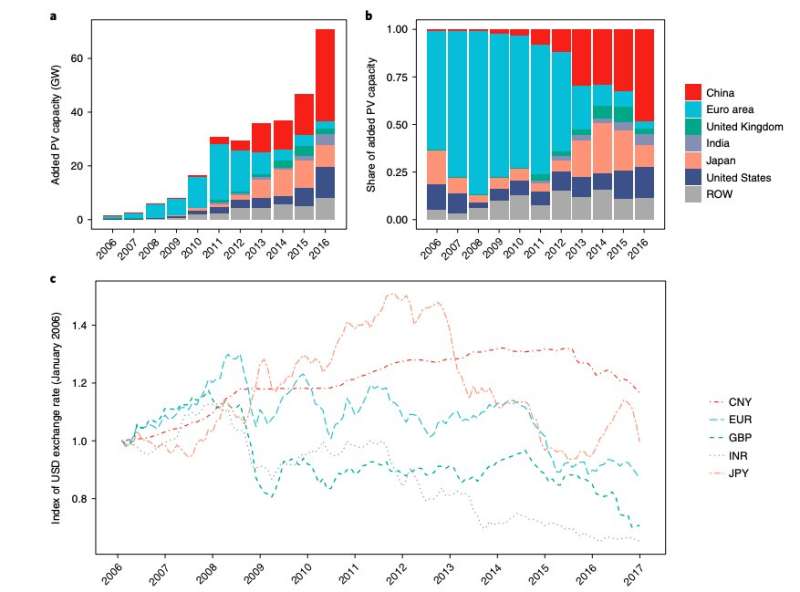February 4, 2020 feature
Exploring the effects of exchange rate fluctuations on technological learning rates

When it comes to predicting the costs of new energy systems and technologies, researchers must consider learning rates, which are estimated measures of technological progress. In fact, technological advances are typically associated with higher technological performance and cheaper costs of production.
Researchers at the Institute for Advanced Sustainability Studies (IASS), the University of Potsdam and ETH Zürich have recently carried out a study investigating the extent to which learning rate estimates actually reflect technological progress, and if they can be influenced by other factors such as exchange rate fluctuations. Their paper, published in Nature Energy, builds on findings collected in their previous research, hinting at a link between exchange rates and global learning rates.
"When finalising a previous paper on learning rates for concentrating solar power, we decided to change the base currency of the analysis from Euros—which made sense for CSP, as it was mainly built in Europe—to dollars, which is the standard currency in global economic analyses," Johan Lilliestam, one of the researchers who carried out the study, told TechXplore. "By doing this, our results changed, which was surprising to us—an effect that we had never heard about in the learning rate literature."
After this previous paper was published, Lilliestam and his colleagues decided to investigate their observations further to better understand why and how the choice of currency can affect learning rates. In their new study, they carried out a series of analyses aimed at unveiling how the choice of currency for a given technology, which is to some extent arbitrary, ultimately affects the empirical observation of learning rates.
The researchers also wanted to quantify this 'exchange rate effect' and introduce a method to make up for this bias. Such a method could ultimately enable more precise empirical estimates of technological progress in a global context.
"We converted the raw data—project costs, expressed in the currency of the country of each project—into different base currencies, so that all data is on an equal basis," Lilliestam explained. "As currencies fluctuate against each other, the costs of projects vary when they are expressed in different currencies and may exaggerate or mask the technological improvement that the learning rate metric is supposed to measure."
The unique method they developed allowed Lilliestam and his colleagues to calculate learning rates in several currencies, showing how large the effect they had previously observed actually is. In their paper, they focused on one illustrative case, that of large-scale photovoltaic plants above 5 MW.
Subsequently, the researchers also devised a set of equations to filter out the effect of currency fluctuations over a specific time period. Using these equations, researchers should be able to produce metrics that are more aligned with what learning rates are actually supposed to measure: technological improvement in a specific research area.
"Our findings show another case of how difficult it is to do empirical research: There are tons of disturbing and confounding factors, and it's hard to know which ones are important," Lilliestam said. "For our community, there are two important implications. First, we show that past global learning rate estimates may be affected by the exchange rate effect and that this effect can be large. Second, our finding is very important for researchers and analysts using learning rate estimates in their models, especially for those running optimisation models."
Optimization models are computational techniques that can be used to predict the best solution to a given problem. As most currently employed optimization models favor cheaper technologies basing their analyses on global learning rates, even a small difference in percentage can influence their final results, identifying specific technologies as more advantageous or suitable for a particular use.
Optimization models are now widely used, both for scientific analysis and policy advice, so their use of biased learning rates can ultimately result in unrealistic policies and technological implementations. By improving the precision of learning rate estimates, the method introduced by Lilliestam and his colleagues could thus also influence the results of these models, leading to more effective and beneficial technology-related policies.
"We are now looking into how policy affects technological change, so conducting analyses applicable to the same field, but focusing more on the drivers of technological learning than ways to assess learning," Lilliestam added.
More information: Johan Lilliestam et al. Understanding and accounting for the effect of exchange rate fluctuations on global learning rates, Nature Energy (2020). DOI: 10.1038/s41560-019-0531-y
Focusing on technological learning in learning rate assessments. socialsciences.nature.com/user … ing-rate-assessments
Johan Lilliestam et al. Empirically observed learning rates for concentrating solar power and their responses to regime change, Nature Energy (2017). DOI: 10.1038/nenergy.2017.94
© 2020 Science X Network




















